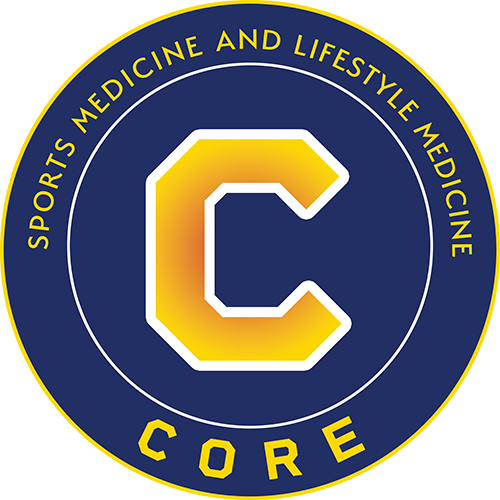Blog Outline
A stress fracture typically feels like a sharp, pinpoint pain that worsens with activity and improves with rest. Unlike muscle soreness or general fatigue, the pain from a stress fracture is more persistent, often occurring in one specific spot and intensifying with repeated impact—such as running or jumping. If left untreated, this pain can become constant and may even lead to a complete fracture. At CORE Sports Medicine & Lifestyle Medicine, we help athletes and active individuals diagnose and treat stress injuries before they escalate into more serious injuries.
Understanding Stress Fractures
A stress fracture is a small crack in a bone caused by repetitive force, often from overuse. They’re common in sports that involve running, jumping, or sudden changes in direction. Unlike traumatic fractures caused by a single impact, stress fractures develop gradually as the bone is subjected to more stress than it can repair over time.
They’re particularly common in:
-
Runners and track athletes
-
Dancers
-
Military personnel
-
Athletes increasing training intensity too quickly
Common Signs and Symptoms of a Stress Fracture
Knowing what a stress fracture feels like can help you catch it early and avoid more severe damage. Common symptoms include:
-
Localized Pain: The pain is usually sharp and centered in one spot. For example, pain on the top of the foot, mid-shin, or hip that you can point to with a finger.
-
Pain That Worsens With Activity: It often starts as mild discomfort but gets worse with continued impact—especially weight-bearing activities like running, jumping, or walking long distances.
-
Relief With Rest: Pain typically lessens or disappears when you’re off your feet but returns when you resume activity.
-
Swelling and Tenderness: The affected area may swell slightly and feel sore when pressed.
-
Pain Earlier in Workouts: Over time, the pain starts earlier in your workout and takes longer to subside afterward.
Where Do Stress Fractures Occur Most Often?
Stress fractures usually occur in weight-bearing bones of the lower body. Common locations include:
-
Shinbone (Tibia): Pain in the lower leg, common in runners.
-
Foot (Metatarsals): Pain on the top of the foot, especially near the second or third toe.
-
Heel (Calcaneus): Aching or sharp pain in the heel, especially during heel strike while running.
-
Hip (Femoral Neck): Deep, aching pain in the groin or outer hip.
-
Pelvis or Sacrum: Pain in the lower back or buttocks, often mistaken for a muscle strain.
Stress Fracture vs. Shin Splints or Soreness
It’s important to differentiate a stress fracture from more common overuse symptoms like shin splints or muscle soreness. Shin splints tend to affect a larger area of the lower leg and feel more like a dull ache. If untreated, shin splints can continue along the continuum to a stress injury and ultimately a stress fracture. Muscle soreness improves with stretching or rest, while a stress fracture continues to hurt with pressure and impact and becomes more localized and persistent over time.
When to See a Doctor
If you suspect a stress injury or stress fracture, don’t delay treatment. The longer it goes undiagnosed, the higher the risk of a complete fracture, which could require surgery or a prolonged recovery. You should consult a sports medicine professional if:
-
Pain persists for several days or worsens with use
-
You have swelling, bruising, or tenderness in one specific area
-
Your activity levels have recently increased significantly
-
Pain returns quickly each time you try to resume training
At CORE Sports Medicine & Lifestyle Medicine, our team often recommends advanced imaging like digital X-rays or MRIs to accurately diagnose stress fractures and rule out other conditions.
Treatment and Recovery
Most stress fractures can heal without surgery, but proper treatment and rest are critical. Your recovery plan may include:
-
Rest and temporary reduction of physical activity
-
Protective footwear or walking boots
-
Physical therapy to strengthen surrounding muscles and correct imbalances
-
Nutritional guidance to support bone health
- Advanced non-surgical treatments such as shockwave therapy
-
A gradual return-to-play program
At CORE Sports Medicine & Lifestyle Medicine, we take a personalized approach to care. Whether you’re a competitive athlete or an active adult, we tailor your treatment to your sport, lifestyle, and goals.
Preventing Future Stress Fractures
Once you’ve had one stress fracture, you may be at higher risk for another. Preventive strategies include:
-
Gradually increasing training intensity
-
Wearing proper footwear
-
Addressing biomechanical issues
-
Getting enough calcium and vitamin D
-
Cross-training to avoid repetitive stress on the same area
Don’t Push Through the Pain—Get Answers Today
If you’re wondering whether your persistent pain is a stress fracture, it’s time to listen to your body. Early evaluation is key to preventing more serious injury and getting back to activity safely.
Schedule a consultation with CORE Sports Medicine & Lifestyle Medicine today and let our team of sports injury specialists help you recover with confidence.






Leave a Reply